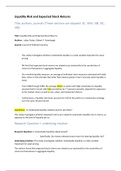Summary
Extensive Summary - Liquidity Risk and Expected Stock Returns Lubos Pastor, Robert F. Stambaugh 2003
- Course
- Institution
This is an extensive summary. The research questions are explained, the underlying intuition my comment about it is provided and the main methodology is given. In this summary you can find a sentence or two about each graph and figure based on the authors conclusion. I also added some comments from...
[Show more]



